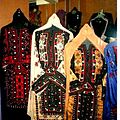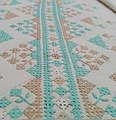|
Part of a series on Baloch People |
|---|
Community
|
|
HistoryAncient Medieval Baloch nationalism . Insurgency in Balochistan . Dad Shah . Baloch people in Iran . Baloch of Afghanistan |
| Culture |
| Languages |
| Religion |
Balochi handicrafts are handicraft or handmade crafted works originating from Baloch people.
Baloch handicrafts is not merely a craft; it serves as a means of cultural identity and expression. Each design often carries symbolic meanings related to Baloch traditions and beliefs.
Handicrafts are part of Baloch culture and play an important role in the family economy, as an occupation that is particularly prevalent among Baloch nomads. Women often engage in these handicrafts to support their families, especially in rural areas where educational and employment opportunities may be limited.
The tradition of crafting these items is passed down through generations, preserving the cultural heritage of the Baloch community.
Needlework
Main articles: Balochi needlework and Balochi clothing
Balochi needlework is a rich and intricate art form that reflects the cultural heritage of the Baloch people. It utilizes various needlework techniques to create stunning patterns and designs, often incorporating vibrant colors and unique motifs.
Balochi needlework is used on Balochi clothing, in some sources, the beginning of this art is 100 to 200 years before Islam, and the available evidence indicates that this method of sewing has been common among the Baloch people since the beginning of Islam, and in The Ilkhanate era, especially the Timurid and Safavid eras, has reached its peak. Balochi needlework is not merely a craft; it serves as a means of cultural identity and expression. Each design often carries symbolic meanings related to Baloch traditions and beliefs.

Traditional Balochi needlework uses organic materials such as cotton, silk, and wool.
Threads are often hand-dyed using natural pigments derived from plants and minerals, contributing to the depth of color in the designs. Decorative elements like mirrors, crystals, and sequins are also incorporated to enhance visual appeal. The embroidery is traditionally performed by women, providing them with a source of income while preserving their cultural heritage.
The embroidery features a variety of geometric and floral patterns that reflect the region's history and cultural influences. Each piece is unique, often taking days or weeks to complete due to the meticulous nature of the work. Recent interest in Balochi embroidery has led to its incorporation into contemporary fashion, maintaining traditional techniques while innovating new designs.
Notable Balochi needlework artisans include Mahtab Norouzi. Farah Diba Pahlavi, the former Shahbanu of Iran, was particularly drawn to Balochi needlework handcrafts and incorporated them into many of her formal dresses. In the 1960s, Mehr Monir Jahanbani, renowned for her discerning eye for traditional craftsmanship, discovered the intricate Baluchi needlework and immediately recognized its potential as a fashion statement. Collaborating with designer Keyvan Khosrovani, Jahanbani began incorporating this exquisite embroidery into contemporary designs, blending it seamlessly with modern aesthetics. Their collaborative efforts culminated in a series of stunning royal dresses for Empress Farah Pahlavi, where the Baluchi needlework became an iconic decorative element.
Balochi mirror work embroidery
Mirror work embroidery is a type of traditional Balochi embroidery as the Balochi women have a special skill in ornamentation of clothes with mirror - work . and art that is used to decorate coats, cloth, hat(pag), local clothing between Baloch of Afghanistan, Pakistan and Iran.

The artistic aspects of sewing these types of mirrors can be used in some cases to decorate some items such as cushions, tablecloths, bags, etc. Mirror work embroidery is also used on local clothes, vests, belts, and wall hangings.
It is used in at least twenty-four Baloch embroidery motifs. Considering cultural ideas, the mirror in Baloch embroidery does not merely serve the purpose of decoration and, like other traditional arts. In some motifs such as Setareh(Balochi: ستاره), Kap and Naal(Balochi: کپ و نال), and Gol Kandi(Balochi: گل کندی), the mirror is associated with light and brightness, and in others such as Harir, Tak Zarafshan, and Gol it is associated with water and prosperity. It seems that in some examples such as Cham Mojeh(Balochi: چم مژه), Koh Bandar(Balochi: کوه بندر), and Koh Sar Asheg(Balochi: کوه سر عاشق); lofty concepts such as love, martyrdom, and sacrifice are the carriers of meaning-making, and in some such as Morvarid(Balochi: مروارید), Nah Adinki(Balochi: نه آدینکی), and Cham Ahog(Balochi: چم آهوگ), and purity are specifically implied. In contrast, in a few examples such as Sherin Jenk(Balochi: شرین جنک) and Dej(Balochi: دژ), only the appearance and splendor caused by the shimmering light in the mirror are displayed as a symbol of power and strength.
Balochi coin work embroidery

Coin work embroidery is one of the handicrafts of Balochistan that that the Baloch generally use to decorate bedspreads or hung under camel's head during ceremonies, and they often hang them on the wall to decorate rooms. Balochi coin embroidery is very popular among the Baloch people in Iran and has created a large market and exported outside Balochistan.
There are two types of coin embroidery: one is made to hang and often has a set of diamond, square and triangle shapes. For this purpose, the fabric is selected in the desired shapes, and according to one's taste, white buttons are sewn on it in a very beautiful way, and small and large mirrors and sequins are placed between the sewn buttons, creating a unique shape.
Balochi rug and carpet
Main article: Balochi rugBalochi rug are typically eight feet in length, which made them lighter and easier to transport. Their material typically includes wool or a mixture of wool and goat hair; newer carpets have a warp made of cotton and sturdy wool pile rugs.
These rugs are renowned for their intricate designs, durability, and use of natural materials. often used for the warp (the vertical threads), providing a sturdy foundation for the rug. Goat and Camel hair, occasionally incorporated for added texture and durability.
The weaving process can take several months, with artisans often working on horizontal looms. Commonly feature geometric shapes such as hexagons, triangles, and rectangles.
These motifs showcase the artistic vision of the weavers. Designs often include camel prints and 'gul' repeat medallions, reflecting the significance of camels to the nomadic lifestyle of the Baloch tribes. Traditional colors include deep reds, blues, and browns, achieved using natural dyes from local plants.
Gallery
-
 Balochi handicrafts
Balochi handicrafts
-
 Balochi dress with Balochi embroidery
Balochi dress with Balochi embroidery
-
 Balochi embroidered cushion
Balochi embroidered cushion
-
 Balochi embroidered ties
Balochi embroidered ties
-
 Balochi dress with Balochi embroidery
Balochi dress with Balochi embroidery
-
 Balochi rug
Balochi rug
-
Mirror embroidery and coin embroidery of the nomadic Baloch
-
 Balochi mirror embroidery
Balochi mirror embroidery
-
 Balochi needlework dress
Balochi needlework dress
-
 Baloch pottery
Baloch pottery
-
 Balochi needlework on the shawl and tent
Balochi needlework on the shawl and tent
-
 Baloch embroidery palivar
Baloch embroidery palivar
-
 Balochistan Traditional Seating Arrangements
Balochistan Traditional Seating Arrangements
See also
References
- ^ "CLOTHING xviii. Clothing of the Baluch in Persia". Encyclopædia Iranica.
- Taheri, Ahmad Reza (2014). A Sociopolitical Study of Iranian Baloch Elites (1979-2013). Lulu.com. ISBN 9781312349681.
- Korn, Jahani, Titus, Agnes , Carina , Paul Brian (2008). The Baloch and Others Linguistic, Historical and Socio-political Perspectives on Pluralism in Balochistan. Reichert Verlag. p. 28. ISBN 9783895005916.
{{cite book}}: CS1 maint: multiple names: authors list (link) - Heidari, Zahra (2016-11-13). "سوزندوزی بلوچ، هنری ریشهدار در تاریخ" [Baloch embroidery, an art rooted in history]. ایسنا (ISNA) (in Persian). Retrieved 2022-03-11.
- Rehman Khan, F. and Malghani, M. and Ayyaz, S., "Construction of Baloch Ethnic Identity through Ethnolinguistic Awareness and Cultural Dynamics", Clark, pp. 440 (2005). Retrieved 2 January 2024.
- ^ Carr, Butler, Anna, Richard (2024). The Routledge Handbook of Tourism and Indigenous Peoples. Taylor & Francis. p. 373. ISBN 9781040086629.
{{cite book}}: CS1 maint: multiple names: authors list (link) - "پوشش گرانقیمت زنان بلوچ" [Expensive clothing of Baloch women]. ایسنا (ISNA) (in Persian). 2015-04-20. Retrieved 2022-03-12.
- Agnoletti, Santoro, Fiore, Piras, Romano,Bazzurro, Mauro, Antonio, Beatrice, Francesco, Federica , Alessandra (2023). Agricultural Heritage Systems in Europe, Asia, Africa, Central and South America. Springer. p. 177. ISBN 9783031448812.
{{cite book}}: CS1 maint: multiple names: authors list (link) - "مهتاب نوروزی؛ نماد نیم قرن سوزن دوزی در بلوچستان" [Mahtab Norouzi; Symbol of half a century of needlework in Balochistan]. BBC News فارسی (in Persian). 16 July 2012. Retrieved 9 May 2022.
- "Artist Spotlight with Bibi Manavi | ArteEast". arteeast.org. 2021-03-23. Retrieved 2024-08-27.
- Rehman, I. A. (1994). Arts and Crafts of Pakistan. Export Promotion Bureau, Government of Pakistan. p. 57.
- "CLOTHING xix. Clothing of the Baluch in Pakistan and Afghanistan". Encyclopædia Iranica.
- Ahmady, Kameel (2013). From Border to Border Research Study on Identity and Ethnicity in Iran. Avaye Buf. p. 100. ISBN 9788794295314.
- ^ Afshar, Iraj (1992). Balochistan and its ancient civilization (in Persian). Printing and Publishing Organization of the Ministry of Culture and Islamic Guidance. pp. 89–90, 101, 127, 376.
- Kakar, Fazal Dad (2000). Cultural Heritage. IUCN, The World Conservation Union. p. 26.
- Zendeh del, Hasan (2000). Effects of nomadic tourism (in Persian). Irangardan. pp. 176&179. ISBN 978-964-6635-29-6.
- "صادرات ۶۰۵ هزار دلار صنایعدستی از سیستان و بلوچستان به ۳ قاره" [Export of $605,000 worth of handicrafts from Sistan and Baluchestan to 3 continents]. Iranian Students' News Agency فارسی (in Persian). 7 August 2023. Retrieved 27 December 2024.
- "سکه دوزی ، هنر اصیل و دیرپای بلوچستان" ["Coin Embroidery", the Original and Long-Lasting Art of Balochistan]. Iranian Students' News Agency فارسی (in Persian). 3 November 2016. Retrieved 27 December 2024.
- ^ "Balochi" (PDF). Indiana University Bloomington. Retrieved January 8, 2024.
- ^ Sadrabadi, Kayvon (2019). The Art of Oriental Rugs - A Weaver's Perspective. Kayvon Sadrabadi. p. 1600. ISBN 978-1-7340167-1-0.
- Agnoletti, Mauro (2023). Agricultural Heritage Systems in Europe, Asia, Africa, Central and South America. Springer International Publishing. p. 187. ISBN 9783031448812.
- Stone, Peter F. (2013). Oriental Rugs. Tuttle Publishing. ISBN 9781462911844.